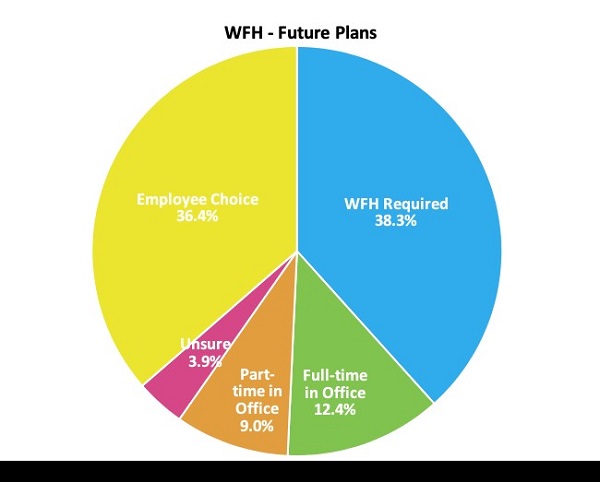Metrigy’s recently published Workplace Collaboration: 2021-22 global research study of 476 organizations found that just 21.4% plan to bring employees back to the office, either full-or part-time once it’s safe to do so. The vast majority, 74.7%, plan to require work-from-home (WFH) for those who are already home or give employees the choice as to whether or not they want to work at home, or in an office, either full or part-time.
The data above reinforces a growing truth about the future of work— for many, the home office is the new office. Business leaders have seen many advantages from enabling WFH. These include financial benefits such as reduced real estate costs, the ability to hire out-of-home markets, and reduced turnover. Employees also prefer the flexibility that comes with avoiding long commutes, as well as the cost savings from eliminating transportation and meal costs. The last year for many organizations has put to rest the idea that WFH employees are less productive than those in the office.
For IT leaders, this means that the days of treating the home office as a best-effort environment are gone. Our data shows that successful home-work initiatives correlate with the following:
- Proactive management of home office IT. This means providing guidance to employees to enable them to select the optimal Internet service provider (ISP) and bandwidth, providing tools to help home employees assess Wi-Fi, and implementing performance management tools that provide insight into application performance for remote workers, especially voice and video. It also means IT needs to help remote workers configure home networks to ensure the adequate performance of business apps, or provision dedicated connectivity and security services to ensure that remote workers aren’t negatively impacted by others in the home contending for bandwidth
- Outfitting home workers with proper endpoints by taking advantage of recently introduced products that use AI to improve audio and visual experiences including noise cancellation headsets and speakerphones, cameras and apps that adjust for background light, and that auto-frames participants. Additionally, organizations may wish to take advantage of features that improve meetings by enabling virtual background and varying options for participant display. Provisioning large monitors, ergonomic keyboards, and other devices that make the home office equal to the company-provided office are all associated with success
Beyond IT, we find that successful companies:
- Provide a stipend, one-time, annual, or monthly, to enable employees to purchase the items they need to optimize their workspace. Our research shows the biggest areas for stipend use include headsets, Wi-Fi upgrades, Internet bandwidth, and physical devices such as chairs, desks, and lighting
- Conduct virtual social events using video conferencing, social software, and team messaging to foster employee engagement and company culture. The average company holds more than three events per week, ranging from health and wellness classes to social get-togethers, to company information sessions
Finally, successful companies are investing more in addressing the security concerns of home workers as collaboration applications and features continue to rapidly advance. Today, many organizations struggle to protect data and systems as employees shift from a virtual private network (VPN) to direct Internet access to applications, and as new collaboration apps bring increasing risk vectors from chats, transcripts, and files shared into meetings, often with guest participants from outside the organization. Today, 40.8% of all of our research participants, but 65.5% of those with the highest return on investment (ROI) for their collaboration investments, have a proactive strategy that addresses all collaboration applications across home and office.
The shift to WFH comes with a fundamental change in what it means to work, and where work is conducted. Business, IT, facilities, and HR leaders must apply the same provisioning, management, engagement, and security approaches that they use within the office to ensure the success of their large, and likely permanent, remote workforce.





